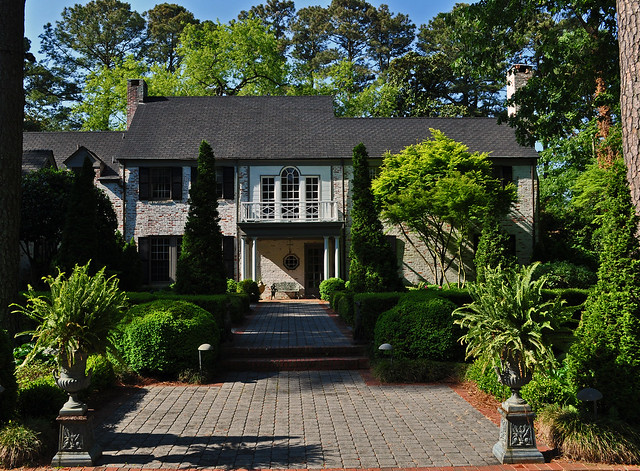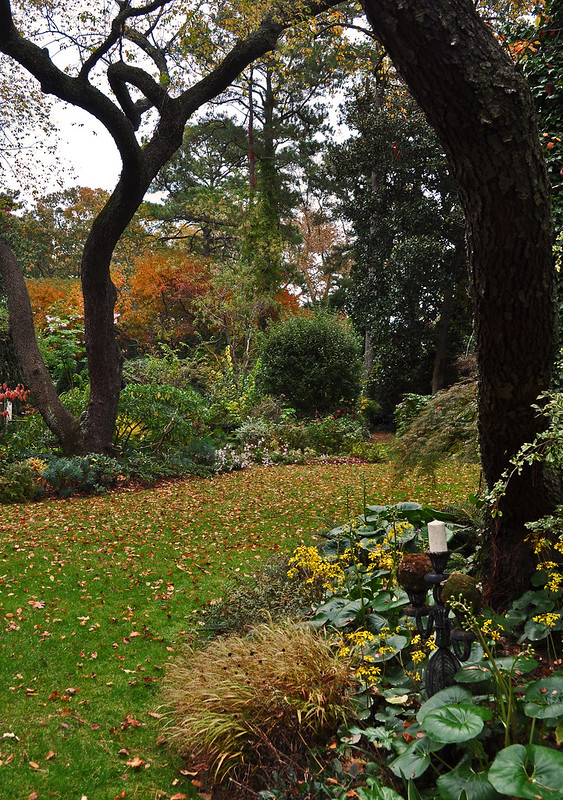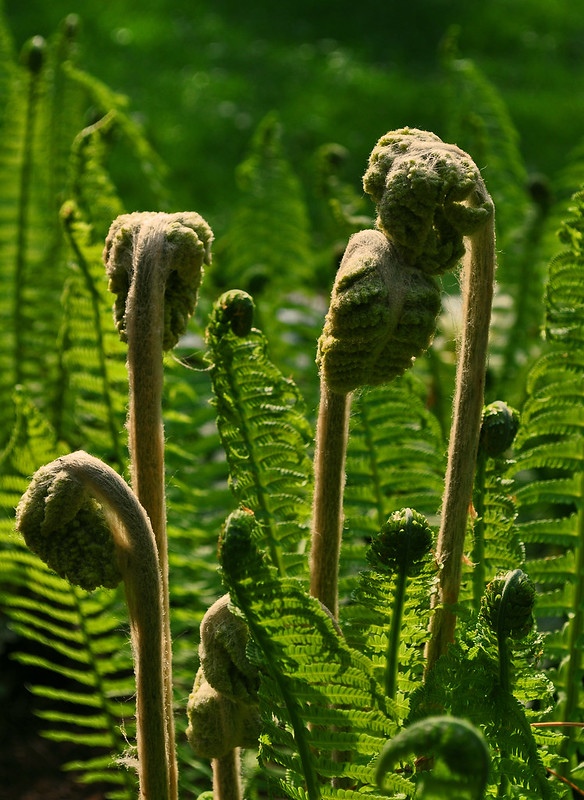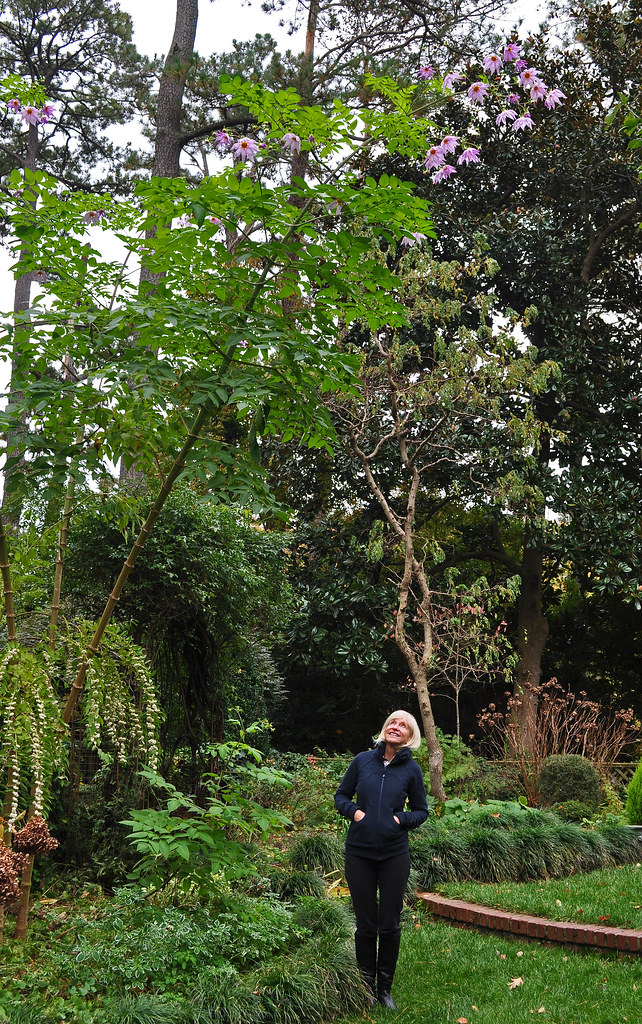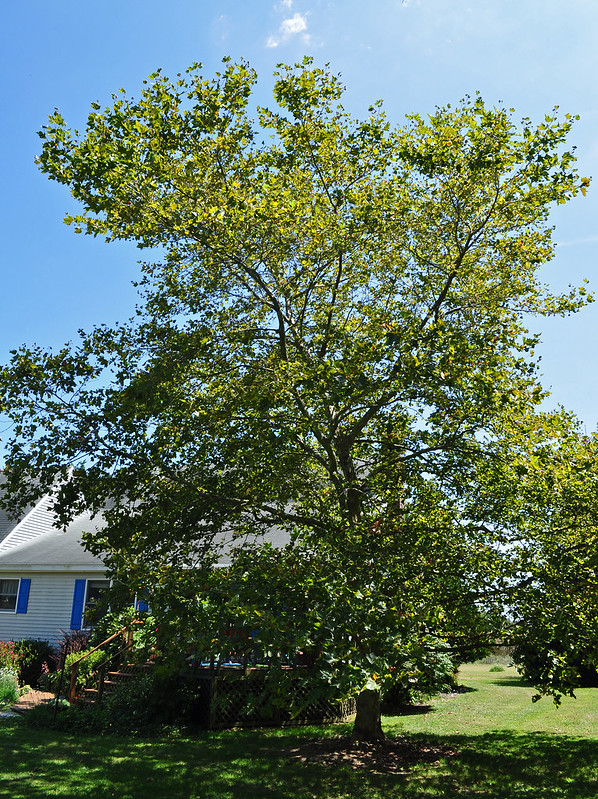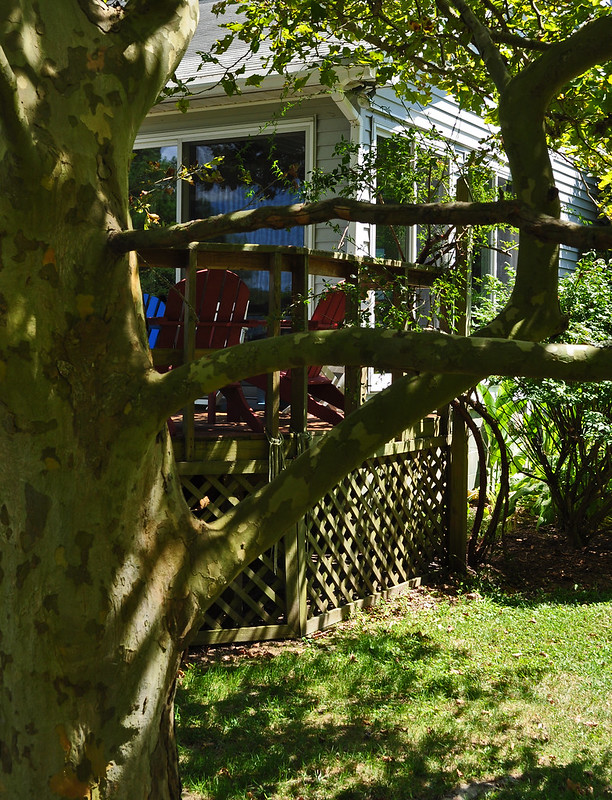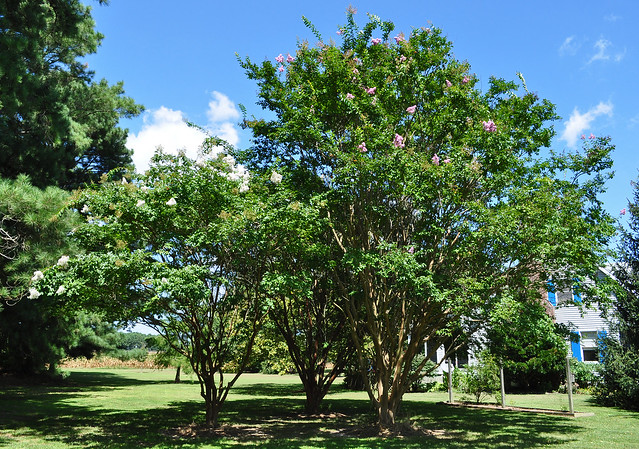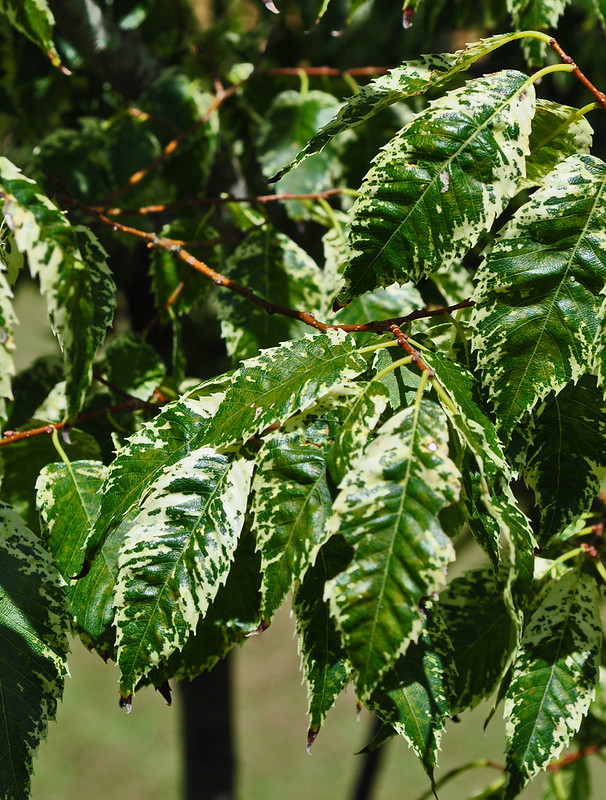The photos were taken over the course of a year on three different visits, and are a mix of spring and fall shots. I took way more pictures than were needed, but given the economy of digital photography, more gives you more to choose from. All of the photo files were delivered unedited, but those that follow I have tinkered with a bit in Photoshop.
September 28, 2015
Reflections on a Coastal Garden
Last year a gardening friend, Mac Houfek, paid me a great honor by asking me to contribute photographs of her garden to a book she was writing about it. Knowing how special her garden was, and how much it means to her, I said yes. I got to know Mac at my last job, where she was one of our landscape clients, and at the garden center I would help her find new and/or special plants. When I started working at the Norfolk Botanical Garden, I was pleased to see that she was an active board member there. In fact, she has dedicated the book to the garden and its staff, and is generously donating all of the book's proceeds to the garden. Although Mac is quick to offer visitors a piece of this plant or that, she is also generous with her knowledge and enthusiasm, especially so with new gardeners.
The photos were taken over the course of a year on three different visits, and are a mix of spring and fall shots. I took way more pictures than were needed, but given the economy of digital photography, more gives you more to choose from. All of the photo files were delivered unedited, but those that follow I have tinkered with a bit in Photoshop.
If you want to see more of my photos from Mac's garden, here is a link to an album on my Flickr page. For more information about Reflections on a Coastal Garden, including how you can get your copy, visit the book's web site.
The photos were taken over the course of a year on three different visits, and are a mix of spring and fall shots. I took way more pictures than were needed, but given the economy of digital photography, more gives you more to choose from. All of the photo files were delivered unedited, but those that follow I have tinkered with a bit in Photoshop.
Location:
Virginia Beach, VA, USA
September 15, 2015
Gloom Day
Let me share you with a gardener's nightmare. Imagine you are recovering from a knee surgery that keeps confined to either the bed, or the couch. Next, imagine you are having your roof rebuilt at the same time as your surgery and subsequent recovery, because the roofing company was three weeks late getting started. Imagine also that you have had repeated conversations with the roofing company about how much your garden means to you, and that all parties have agreed upon several designated "drop zones", in order to minimize damage. Now imagine that on the first day of construction that pallets of heavy roofing materials are deliberately unloaded into your garden beds, obliterating everything planted underneath, this so the delivery driver does not run the risk of getting fined by the city for blocking public right-of-way access, even though there are several people ready to unload the contents of the pallets instantaneously into designated staging areas. Now go back to that couch for a minute, and imagine lying there on your back, looking out your windows, as the accumulated debris of a 100 year old roof is allowed to rain down into your garden, with no regard as to the aforementioned drop zones, and at this point all you can do is close the blinds. This, my gardening friends, was my living nightmare.
If there can be any bright spots in all of this, there were only a couple of things killed outright; the perennials may recover by next spring; I am now off the couch and walking without crutches; and I think we've gotten a good roof, but boy is the garden ugly right now.
If there can be any bright spots in all of this, there were only a couple of things killed outright; the perennials may recover by next spring; I am now off the couch and walking without crutches; and I think we've gotten a good roof, but boy is the garden ugly right now.
 |
| Newly prostrate Crinum |
 |
| Rhododendron x 'Red Ruffles' |
 |
| Impatiens hybrida 'Fusion Glow Yellow' |
 |
| Stipa tenuissima |
 |
| Carex oshimensis 'Everillo' |
 |
| Hosta 'Pineapple Upside-down Cake' |
 |
| Hydrangea macrophylla 'Amethyst' |
 |
| Helleborus x hybridus 'Spring Promise Sally' and Ophiopogon nigrescens |
 |
| Tricyrtis hirta |
 |
| Not the Designated Drop Zone |
After seeing this, I highly recommend you visit Carol at May Dreams Garden, who hosts Garden Bloggers Bloom Day, where you can see gardens more uplifting.
September 11, 2015
Christmas Trees
Years before my parents retired, they purchased a piece of land from my uncle on which they would eventually build a new house. The property was bordered by a freshwater pond, salt marsh, a scruffy brackish woodland, and acres of farmland, all within in earshot of the Atlantic. The land that wasn't wet or water was wide open and treeless. While the house was still a dream, they began planting trees, mainly pines, cedars, and an assortment of fruit trees. When I began my life in horticulture I started giving them trees for Christmas, each year something different, and something I wanted to grow myself, but didn't have the room for.
One of the first trees I gave them was a blue Atlas cedar (Cedrus atlantica 'Glauca'). I got this tree from the first garden center I ever worked for, and when I planted the tree, it had a distinct curve in the trunk, which I thought looked artistic, but it eventually grew straighter. Over the past few years the sapsuckers have managed to put it into a bit of a decline. The tree to the right front of the cedar is a fruitless sweet gum (Liquidambar styraciflua 'Rotundiloba'). I came across this cultivar while working for another garden center, and thought surely it would be a great seller, but was wrong.
Another early tree was a London planetree (Platanus x acerifolia), which was planted to shade their deck, and from which its handsome bark and bone-like winter structure could be admired. Despite a little late-summer foliage funk every other year or so, it has done very well and is now beginning to tower over the house.
When it looked as if the garden center where I first worked was getting ready to fold, I got a job at one of the big box stores as a Plant Specialist. As it turned out, Plant Specialist meant someone who spends more time schlepping bags of mulch, fence panels, and concrete blocks from one place to another, then he does specializing in plants. While I worked there I purchased three crapemyrtles labeled as Natchez, envisioning a space, sometime in the future, underneath three mature and identical trees. The years progressed. and it became apparent that one of the trees was not Natchez. As it was, this big box store did not survive the onslaught of Home Depot and Lowe's, probably in no small part for selling mislabelled plants.
While I was still working at the big box store, I wanted to get my parents a ginkgo (Ginkgo biloba), but we had already sold all of our nursery stock at stupid low prices, and literally tossed what didn't sell into the dumpster per my boss's instructions, to make room for cut Christmas trees. So I drove way out into the country to a garden center where I was told you could get anything, including ginkgoes. I fell in love with the place and got a job there the next year.
While I worked there I came across many unusual trees, including a dawn redwood with golden foliage (Metasequoia glyptostroboides 'Ogon'). It once had a single trunk, but male deer, rubbing their antlers turned it into a multi-stemmed shrub. I still like it though.
While at the garden center in the country, the owner had a yard sale of sorts, and I was able to pick up a variegated zelkova (Zelkova serrata 'Variegata') for a good price. Overall, it has never done that well, but on close inspection, the foliage looks nice. At my new job I am beginning to curse this species, as I am needing to pull its seedlings like so many dandelions.
One of our big sellers at the garden center in the country was Chindo viburnum (Viburnum awabuki 'Chindo'). Technically it's a shrub, and this post is about trees, but this plant has reached a tree-like height next to my parent's chimney.
One year at the garden center in the country, we gave away free trees with a coupon. I got in several hundred bare-root saplings from the state forestry department, and we potted them into 1 gallon pots. We had several species, but everyone's favorite were the bald cypress (Taxodium distichum). Even though I had the pick of the crop, the one I got for my parents was barely wider than a pencil when it was planted. Now it is lush and full, and every bit a healthy, still-young tree, and a fine example of one of my favorite species.
Over the last few years, I have had to switch to Christmas shrubs and Christmas perennials. You can only put so many trees in a yard before you turn it into a forest, though that's not necessarily a bad thing.
One of the first trees I gave them was a blue Atlas cedar (Cedrus atlantica 'Glauca'). I got this tree from the first garden center I ever worked for, and when I planted the tree, it had a distinct curve in the trunk, which I thought looked artistic, but it eventually grew straighter. Over the past few years the sapsuckers have managed to put it into a bit of a decline. The tree to the right front of the cedar is a fruitless sweet gum (Liquidambar styraciflua 'Rotundiloba'). I came across this cultivar while working for another garden center, and thought surely it would be a great seller, but was wrong.
Another early tree was a London planetree (Platanus x acerifolia), which was planted to shade their deck, and from which its handsome bark and bone-like winter structure could be admired. Despite a little late-summer foliage funk every other year or so, it has done very well and is now beginning to tower over the house.
When it looked as if the garden center where I first worked was getting ready to fold, I got a job at one of the big box stores as a Plant Specialist. As it turned out, Plant Specialist meant someone who spends more time schlepping bags of mulch, fence panels, and concrete blocks from one place to another, then he does specializing in plants. While I worked there I purchased three crapemyrtles labeled as Natchez, envisioning a space, sometime in the future, underneath three mature and identical trees. The years progressed. and it became apparent that one of the trees was not Natchez. As it was, this big box store did not survive the onslaught of Home Depot and Lowe's, probably in no small part for selling mislabelled plants.
While I was still working at the big box store, I wanted to get my parents a ginkgo (Ginkgo biloba), but we had already sold all of our nursery stock at stupid low prices, and literally tossed what didn't sell into the dumpster per my boss's instructions, to make room for cut Christmas trees. So I drove way out into the country to a garden center where I was told you could get anything, including ginkgoes. I fell in love with the place and got a job there the next year.
While I worked there I came across many unusual trees, including a dawn redwood with golden foliage (Metasequoia glyptostroboides 'Ogon'). It once had a single trunk, but male deer, rubbing their antlers turned it into a multi-stemmed shrub. I still like it though.
While at the garden center in the country, the owner had a yard sale of sorts, and I was able to pick up a variegated zelkova (Zelkova serrata 'Variegata') for a good price. Overall, it has never done that well, but on close inspection, the foliage looks nice. At my new job I am beginning to curse this species, as I am needing to pull its seedlings like so many dandelions.
One of our big sellers at the garden center in the country was Chindo viburnum (Viburnum awabuki 'Chindo'). Technically it's a shrub, and this post is about trees, but this plant has reached a tree-like height next to my parent's chimney.
One year at the garden center in the country, we gave away free trees with a coupon. I got in several hundred bare-root saplings from the state forestry department, and we potted them into 1 gallon pots. We had several species, but everyone's favorite were the bald cypress (Taxodium distichum). Even though I had the pick of the crop, the one I got for my parents was barely wider than a pencil when it was planted. Now it is lush and full, and every bit a healthy, still-young tree, and a fine example of one of my favorite species.
Over the last few years, I have had to switch to Christmas shrubs and Christmas perennials. You can only put so many trees in a yard before you turn it into a forest, though that's not necessarily a bad thing.
Subscribe to:
Posts (Atom)
